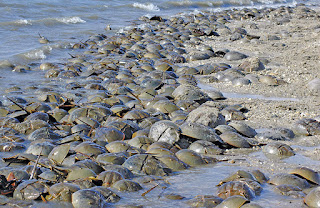Timing is everything. Each spring, shorebirds migrate from wintering grounds in South America to breeding grounds in the Arctic. These birds have some of the longest migrations known.
Delaware Bay is the prime stopover site and the birds’ stop coincides with horseshoe crab spawning. Shorebirds like the red knot, ruddy turnstone and semipalmated sandpiper, as well as many others, rely on horseshoe crab eggs to replenish their energy reserves before heading to their Arctic nesting grounds.
The birds arrive in the Arctic before insects emerge. This means that they must leave Delaware Bay with enough energy reserves to make the trip to the Arctic and survive without food until well after they have laid their eggs. If they have not accumulated enough fat reserves at the bay, they may not be able to breed.
More


No comments:
Post a Comment